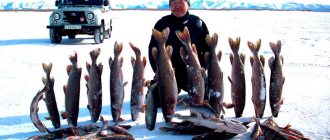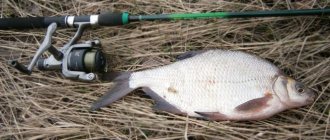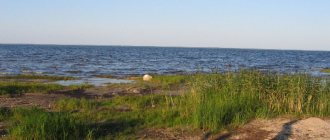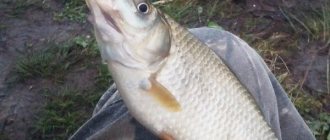Fishing for omul is especially popular during warm and cold periods. Omul grows up to 64 cm with a maximum weight of 3 kg. The main habitat for omul fishing is Siberia. Omul is a commercial species of whitefish.
There are two main types of omul – Baikal and Arctic. The most famous is the Baikal omul, traditionally eaten by residents of the Baikal regions.
Many fishermen mistakenly believe that omul is caught only in winter. Perhaps this is due to the fact that for summer fishing there must be stable, good, warm weather, which does not happen very often on Lake Baikal. The weather here can often change dramatically, and then there is a high probability of being left without a catch.
You can catch omul from the shore in summer, since during this season the fish prefers shallow water. Experienced fishermen use a spinning rod with pink bait, since this is the color of crustaceans, the favorite delicacy of fish. You can also fish with a fishing rod, but you will definitely need a landing net, since the fish has a weak and thin lip and can tear if hooked sharply.
You can use different things as bait. The omul is curious and can bite on anything, even painted foam rubber, although it especially loves pieces of fish. If there is no bite for a long time, then you should change the spoon.
Fishing for omul from a boat is especially productive. It is better to fish at night, at a depth of at least 25 meters, illuminating the bottom with a headlight. Small crustaceans will swim into the light. Of the gear, the “donk” is preferable. You need to release the donkey into the illuminated area. The omul will react to the vibration of the fly, and at this moment it is necessary to hook it.
In the summer, schools of omul prefer to stay in shallow water, only in some cases visiting deeper places from time to time.
Experienced fishermen know that when choosing between moving and stationary bait, omul gives preference to the first, which resembles small crustaceans. Therefore, spinning can be considered the most acceptable and exciting type of omul fishing. However, there are rules here too. It is worth remembering that omul prefers small baits of various colors. The main popular colors are pink, orange or with a hint of red. But omul has an unpredictable character, so the possibility of successful hunting with baits of other colors cannot be ruled out. The most important qualities of a fisherman who decides to catch a Baikal omul are attentiveness and caution.
Fans of float rigs also have the opportunity to compete with this amazing fish. Fishing for omul in summer from the shore in this case is carried out in shallow water. The bait used for fishing can be the most unpredictable: from earthworms to artificial foam rubber in red colors.
When catching omul, you must remember that it has very weak lips, therefore, when going fishing, the fisherman must have a landing net in his arsenal.
The uniqueness of Lake Baikal and the amazing purity of its water make ice fishing for omul in winter a very special experience. Where else, if not on Baikal, can you catch fish “at a glance”, when, lying on your stomach on the ice and looking into the hole, you can see the fish passing in the depths. This is the main feature of winter omul fishing.
“Sneak fishing” allows you to see whether there are omuls in the area of the hole and whether they are interested in the bait. Omul is a rather curious fish and sometimes beads, wire or just a shiny thread can attract its attention. The main thing is to guess what exactly these omuls like.
Since the Baikal omul is quite cautious, even the silhouette of a fisherman near the hole, visible through the transparent ice, can spook it. In this case, crushed ice moistened with water is poured near the hole, which quickly freezes and does not allow the omul to “peep.”
When fishing for omul in winter, it is worth stocking up on feeding. Most often, a drill is used for this purpose. It is poured into the hole on the eve of fishing or immediately before it, and then there will be much more omul caught.
For winter ice fishing, it is better to go to Elenka Island. This road runs from the village of Kurma along the ice, the distance of which is about thirty kilometers. Also noted are places rich in omul: Tonkiy Mys, Barakchin, and Nightingale Grove.
However, omul is capricious and unpredictable. You can go on a five-day fishing trip and catch omul only in the last two hours. This is also evidenced by the variety of baits, which are better to change even during one day of fishing. And yet, the time and effort spent on this royally delicious fish is worth it.
Catching omul video
Fishing for omul on Baikal video (on open water: “Omul on Baikal.” Video author Sergey Shepovalov.
Fishing for omul on Lake Baikal video (from the ice): “Fishing for omul on Lake Baikal BULDAKOV and POLOSKOV.” The author of the video is Alexey Poloskov. About the video: 8 Nov. 2012 Baikal. Small sea. Bormash fishing for omul. Spring 2012. Video by Nikulin E.A.
Omul
- fish of the salmon family. Grows up to 3 kg.
There are several types of omul, depending on their habitat
. Only in Lake Baikal there are 4 populations of this fish, they are also called races. They are divided into these same races according to the places and times of spawning. But contrary to the beliefs of many people, omul lives not only in Baikal; there are also separate species of omul that live in the surrounding, near-Baikal lakes and even in the Arctic Ocean. The latter, by the way, is simply an omul, so to speak, an ordinary one, and the Baikal and others are already its subspecies. Although for many, omul is associated specifically with Baikal, and since omul means Baikal. Let's look at the varieties of omul.
Types of omul:
- Baikal omul
-Barguzinsky
-Malomorsky
-ambassadorial
-Selenga
- Omul Penzhinsky
- Yakut omul
Well, with the first species everything is clear - these are the omul races living in Lake Baikal. Yakut omul is an inhabitant of the Arctic Ocean. Penzhina omul - from a biological point of view, is no different from its Baikal relative, but as you can guess from the name, it lives in the Penzhina and Talovka rivers. This species is listed in the Red Book due to uncontrolled fishing by local fishermen and risks disappearing from the face of the Earth forever. But the range of all these species of omul does not extend beyond the borders of Siberia, so omul can rightfully be considered its calling card.
In winter, omul often stays at great depths, which can be explained by the constant temperature under a thick layer of water. Local fishermen set their nets at a depth of up to 200 meters and say that omul can be found even deeper. But he doesn’t always go that deep. However, this fish never stands still and is in constant migration.
With the arrival of warmth and an increase in water temperature, the omul comes out of the depths in search of food in shallow water. And in summer, in calm weather, the omul swims close to the surface of the water.
When to catch omul
.Omul is caught all year round, not counting the spawning break. During the spawning season, catching omul is strictly prohibited by law.
Omul is a rather complex fish. Without certain skills it will be very difficult to catch him. Therefore, beginners who come to catch this famous fish are often left with nothing.
Where and how to catch omul, what baits and gear are suitable for fishing
Omul belongs to the semi-anadromous whitefish. The omul is surrounded by an aura of mystery; most people believe that this fish lives only in Lake Baikal. In fact, two subspecies of this fish and several residential forms live in Russia. In addition, omul is also found in North America. The Arctic omul is considered a larger subspecies; its weight can reach 5 kg. The Baikal omul is smaller, but there are cases of catching individuals weighing about 7 kg. The Arctic omul occupies the northernmost habitat of all whitefish. Omul is considered a slow-growing species; at the age of 7 years it measures 300-400 g.
Fishing for omul in winter
What to use to catch omul in winter. Features of winter fishing.
Winter omul fishing
It is considered easier, however, it is also full of various tricks, without knowledge of which it may not work. The peculiarity of this fishing is very clean and transparent ice, and under the ice there is equally clear water. This makes it possible to observe the fish that approaches the bait and draw appropriate conclusions. But with bait, omul can get on your nerves like no other. They catch it mainly with artificial flies, and use bormysh as bait - these are Baikal shrimps. It is best to attach several flies to one fishing rod, six of them, the chances of catching will be greater. The fact is that this fish has a peculiar character. Today an omul can rush to any bait offered, and tomorrow it can flatly refuse all of them. Therefore, you need to have more than a dozen of them in stock. Local fishermen use rather unusual materials to make baits: beads, foam rubber, fishing line and even ordinary wire. Lures for omul should be of different shades of red, which is so attractive to this fish.
In my blog, I have already written several times that I am an avid fisherman and have traveled almost throughout our vast country. Just recently I went fishing on Lake Baikal. Not going there for omul in the summer is a sin!
I had a great time fishing on Lake Baikal in June.
The local nature amazes with its beauty, and the reservoirs with their generosity. This is an unforgettable experience. I think everyone should see these places: fisherman, tourists, and just vacationers.
Fishing on Lake Baikal in the summer for omul was recommended to me by a friend of mine who lives in these parts. He advised fishing in one of the shallowest bays rich in fish called Mukhor. I planned fishing on Lake Baikal in the summer, and I decided to definitely hunt for omul, because everyone who had been here boasted about the incredible catches of this valuable commercial underwater inhabitant.
Amateurs usually catch it in winter, and the summer season is the domain of professionals. It is valued not only for its tasty, but also for its very healthy meat, which, by the way, is a delicacy. On the advice of local fishermen, I used float gear, but spinning gear can also be used. Here, by the way, it is prohibited to fish with nets and seines. Poaching is severely punished.
You can fish both from a boat and from the shore.
In warm weather, schools of omul try to stay in shallow water, which is why I went to Mukhor. It should be remembered that this cunning fish is more readily caught on a moving bait. He prefers small baits that are always brightly colored: orange, pink or red.
As bait for a float rod, I recommend using earthworms, larvae of various insects, or even pieces of red foam rubber. You should also have a landing net with you, because this fish has very weak lips.
Fishing on Lake Baikal in summer
Fishing on beautiful Baikal in summer is unforgettable! This is what I want to talk about and what I want to write about.
Having caught a couple of omels using the methods described above, I got ready to catch my favorite predator - pike, although, to tell the truth, there are very few of them here. This is all due to poaching, which still occurs. I caught it with a spoon from a boat. The predator is found here not only in shallow waters. The best time for fishing is evening. I also caught several small perches. You are unlikely to meet large ones here. I also caught the hook of the Siberian roach - beautiful, tasty, but extremely capricious. I was warned that it does not bite well, so I was proud of myself for catching such a cunning fish. I fed her dough from the boat. She may also like bread and earthworms. But I even photographed the grayling. An unexpected trophy for me. This is the pride of the lake! I caught it with a spoon near a rocky cape.
Fishing on the Small Sea. Baikal in summer
Many people love fishing on the Small Sea of Baikal in the summer. This is a part of the lake separated by Olkhon Island. My friend chose a place not far from the Mandarkhan recreation center. Reviews about this place from him are only positive. I plan to come there next time.
I visited the most gorgeous lake in Russia! On a quiet sunny day, rocking quietly on a boat - what could be better? My heart skips a beat when I remember this harmonious picture. The water here is so clear that you are amazed! The fish is large, clean, beautiful, fifty different species. And it's all very close!
Fishing on Lake Baikal in June is something special. Nature amazes with its picturesqueness. I came here by car. I spent the night right on the shore, in my car. I cooked fish soup, drank tea, and looked at the beautiful expanses of water. If I could have sung, I would have sung! I was so happy and satisfied.
Lovers of omul probably know that this fish of the salmon family is found everywhere on Lake Baikal. On the territory of this lake you can find several of its varieties, including Posolskaya and Selenga (the largest). The omul winters at great depths. There he is attracted by constant temperature and availability of food. To catch, you have to lower the nets under water to a depth of 200 meters. This is not very convenient, since when lowering the net, the bait may fall off the hook, and when rising, the fish may fall off.
On warm days, the omul rises to the surface in search of feeding places. This fish is very popular among fishermen. For its beauty, limited habitats and amazing taste, they even nicknamed it “noble fish.”
The fishing season on Lake Baikal begins in March - April. Ice fishing enthusiasts from all over the country come here, set up tents, park their cars, live, cook and sleep. As soon as warm days arrive, the omul begins to rise to the surface and look for feeding places. However, he is very easy to spook. The slightest extraneous sound, like the crunch of ice or the noise of a car, and the fish instantly goes into the depths. And only if the omul has already been hooked, it humbly awaits its fate, and does not resist, like grayling.
Catching omul from a boat in the dark is very successful. Illuminate the water with a flashlight. First, small crustaceans will come to light, and then - hunting fish, including omul. Of the gear, preference should be given to the donka, although you can use others.
Often, through the unusually transparent ice of Lake Baikal, you can see fish swimming literally under your feet. In order not to scare away the fish, it is recommended to cover the ice with snow crumbs.
Distribution and diet
In Russia, the fish is found in all northern reservoirs, except for the Ob River. Numerous schools are found in Pechora, Yenisei and Lena. In America, the population is found both at Cape Barrow and in Cornation Bay.
Baikal migrants feel great in the Amur reservoirs. The length of the basins and the diversity of the topography led to minor physiological changes. Representatives are found in the coastal zone and in deep water (up to 350 m).
Favorite dishes include:
- plankton;
- larvae;
- fry;
- mysid;
- crustaceans.
At night they attract attention with the help of a powerful flashlight. The fish sees the bait and approaches the boat
For bottom activities, gear with weights and habits with a nozzle is used. In cold weather, live bait is replaced with red flies.
Lures for catching omul
One of the most important stages of preparing for fishing is. Every real fisherman has in his arsenal more than one set of various fishing rods, differing in color and suit of “fly” (artificial bait). The barmash-shaped “fly” is best suited for catching omul. The bait is made from buckle and the fly is made from English cloth.
The best bait for omul will be a moving one. Local residents use everything they can get their hands on, any things and even pieces of multi-colored foam rubber. But omul bites best on pieces of fish. However, if you prefer spinning, then everything is much more complicated; the result will greatly depend on the mood of the fish.
Since the omul is a schooling fish, in winter fishermen have to rely only on their intuition and experience - its movement routes are hidden by a thick layer of ice.
A few hours before the start of fishing, experienced fishermen feed the future catch by pouring a small amount of live food into the holes. Bormash (a small arthropod that resembles a shrimp) is perfect for this role. For one fishing trip you need a little bait, no more than a half-liter jar, a maximum of a liter. But we must remember that the drill can die in a jar. Therefore, the best place to store it is an ordinary felt boot. During the night, most of the bait will most likely be eaten by fish or carried away by the current. But some impudent individuals will swim near the hole, waiting for a repeat of the free banquet.
By watching the weather, you can determine how successful the fishing will be in the coming day. In warm weather, the best bite for omul is in the early morning and late evening. With a sudden change in weather, the bite stops. The powerful cold barguzin also has a negative effect on fishing. But snowfall and strong winds are not at all an obstacle to successful fishing.
Caught a fish!
With the onset of dawn, the biting usually stops. Each fisherman carefully watches his hole in order to be the first to notice the approach of fish. You can wait several hours. But then everyone freezes - a big school appears! Only occasionally, in different places, fishermen jump at the holes, taking out white-maned prey.
To lure fish out of the depths (a school usually doesn’t stay in one place for long) and prolong the pleasure of fishing, you need to constantly pour drill into the hole. It's just science! It is necessary to take into account not only the presence of a current, but also its strength. To prevent a strong current from dragging away the fertilizer, it is poured into the outer hole, and if the current is weak or absent at all, then into the holes in the center. Experienced fishermen usually do not let the process take its course and manage it sensitively.
When everything finally calms down, the catch count begins. The entire Baikal freezes in anticipation of a new approach! The successful fisherman will still have many reasons to rejoice. But we should not forget about the restrictions on omul fishing, so some lucky ones may return home before dark. Omul sees perfectly in the dark, so the hardiest fishermen also stay for the evening bite, which lasts almost until midnight.
As you can see, the secrets of ice fishing for Baikal omul are quite simple, and the pleasure of such fishing can hardly be overestimated!
Catching omul on Baikal video
Omul
- fish of the salmon family. Grows up to 3 kg.
There are several types of omul, depending on their habitat
. Only in Lake Baikal there are 4 populations of this fish, they are also called races. They are divided into these same races according to points and times of spawning. But contrary to the beliefs of many people, omul lives not only in Baikal; there are also separate species of omul that live in the surrounding lakes near Baikal and even in the Arctic Ocean. The latter, by the way, is simply omul, so to pronounce ordinary, and Baikal and others are already its subspecies. Although for many, omul is associated with Baikal itself, and since omul means Baikal. Let's look at the varieties of omul.
Omul appearances:
- Baikal omul
-Barguzinsky
-Malomorsky
-ambassadorial
-Selenga
- Omul Penzhinsky
- Yakut omul
Well, with the first appearance everything is clear - these are the omul races living in Lake Baikal. Yakut omul is an inhabitant of the Nordic Ocean. Penzhina omul - from a biological point of view, does not differ in any way from its Baikal relative, but as you can guess from the name, it lives in the Penzhina and Talovka rivers. This species is included in the Red Book due to uncontrolled fishing by local fishermen and risks disappearing from the face of the Earth forever. But the range of all these species of omul does not extend beyond the borders of Siberia, so omul can rightfully be considered its calling card.
In winter, omul often stays at great depths, which can be explained by the constant temperature under a thick layer of water. Local fishermen set nets at depths of up to 200 meters and report that omul can be found even deeper. But he doesn’t always go that deep. However, this fish never stands at the point and is in constant migration.
With the arrival of warmth and an increase in water temperature, the omul comes out of the depths in search of food in shallow water. And in summer, in calm weather, the omul swims close to the surface of the water.
When to catch omul
.Omul is caught all year round, without a break for spawning. During the spawning season, catching omul is strictly prohibited by law.
Omul will be a difficult fish. Without certain skills it will be very difficult to catch him. Therefore, beginners who come to catch this famous fish are often left with nothing.
Spawning and reproduction
The omul fish reaches sexual maturity at 7-8 years of age, and in males this occurs a year earlier than in females. Mature individuals gather in large flocks and rise up the rivers, swimming into slightly salty areas near the seas. During migration, fish try to stay as far from the shore as possible. They can travel 1-1.5 thousand kilometers in search of a suitable place to lay eggs.
This species spawns in autumn, when the water temperature in northern rivers drops to 2-4 °C. This is due to the very long incubation period of eggs - 6-7 months or more. The female chooses places for laying eggs at a depth of about 2 meters, with sandy and pebbly soil and a strong current. Approaching the spawning grounds, a large school of fish is divided into small groups. As a rule, the spawning process occurs at night.
The caviar is not sticky and does not cling to the bottom or leaves, which allows river water to carry it into secluded deep places further downstream, all the way to the seas. The diameter of the eggs is about 1.5-2 mm; in one egg bed there are up to 65-67 thousand pieces. They tolerate cold well and continue to develop slowly even at water temperatures of 0.2–0.5 °C.
The fry hatch between April and May, when the water warms up to approximately 6 °C. Usually this period coincides with the beginning of river ice movement. The cubs live in sea waters for about a month. Closer to summer, when the water temperature rises to 12 °C or more, they leave their birthplace and swim into the rivers.
Due to the slow maturation of the omul and the long incubation period of the eggs, the female manages to give birth only 2-3 times during her life. Due to the fact that the species is under threat of extinction, artificial incubation of eggs is actively practiced - they are collected in basins, mixed with milk and placed in special containers where nothing will threaten the eggs and fry.
Fishing for omul in winter
What to use to catch omul in winter. Features of winter fishing.
Winter omul fishing
It is considered easier, however, it is also full of various tricks, without knowledge of which winter fishing may not work. The peculiarity of this fishing is very clean and transparent ice, and under the ice there is equally clear water. This makes it possible to observe the fish that approaches the bait and draw appropriate conclusions. But with bait, omul can get on your nerves like no other. They catch it mainly with fake flies, and use bormysh as bait - these are Baikal shrimps. It’s better to attach several flies to one fishing rod, six of them, the chances of catching will be greater. The fact is that this fish has a peculiar character. Today an omul can attack any offered bait, and tomorrow it can flatly refuse all of them. Therefore, you need to have more than a dozen of them in stock. Local fishermen use quite unusual materials to make baits: beads, foam rubber, fishing line and even ordinary wire. Lures for omul should be of various shades of scarlet, which is so attractive to this fish.
At the same time, catch pike perch with a spoon.








